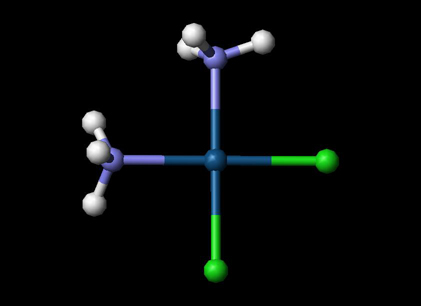Cisplatin Molecule

Ball and Stick Model for Cisplantin Molecule
To View the Cisplatin Molecule in 3D --->>in 3D with Jsmol
Cisplatin, cisplatinum or cis-diamminedichloridoplatinum(II) (CDDP) is a platinum-based chemotherapy drug used to treat various types of cancers, including sarcomas, some carcinomas (e.g. small cell lung cancer, and ovarian cancer), lymphomas and germ cell tumors. It was the first member of its class, which now also includes carboplatin and oxaliplatin.
Upon administration, a chloride ligand undergoes slow displacement with water (an aqua ligand) molecules, in a process termed aquation. The aqua ligand in the resulting [PtCl(H2O)(NH3)2]+ is easily displaced, allowing cisplatin to coordinate a basic site in DNA. Subsequently, the platnum cross-links two bases via displacement of the other chloride ligand.[1] Cisplatin crosslinks DNA in several different ways, interfering with cell division by mitosis. The damaged DNA elicits DNA repair mechanisms, which in turn activate apoptosis when repair proves impossible.
Most notable among the DNA changes are the 1,2-intrastrand cross-links with purine bases. These include 1,2-intrastrand d(GpG) adducts which form nearly 90% of the adducts and the less common 1,2-intrastrand d(ApG) adducts. 1,3-intrastrand d(GpXpG) adducts occur but are readily excised by the nucleotide excision repair (NER) . Other adducts include inter-strand crosslinks and nonfunctional adducts that have been postulated to contribute to cisplatin's activity. Interaction with cellular proteins, particularly HMG domain proteins, has also been advanced as a mechanism of interfering with mitosis, although this is probably not its primary method of action.
Note that although cisplatin is frequently designated as an alkylating agent, it has no alkyl group and cannot carry out alkylating reactions. It is correctly classified as alkylating-like.
Transplatin, the trans diastereomer of cisplatin, has formula trans-[PtCl2(NH3)2] and does not exhibit a comparably useful pharmacological effect. Its low activity is generally thought to be due to rapid deactivation of the drug before it can arrive at the DNA.[citation needed] It is toxic, and it is desirable to test batches of cis-platin for the absence of the trans isomer. In a procedure by Woollins et al., which is based on the classic 'Kurnakov test', thiourea reacts with the sample to give derivatives are easily separated and detected by HPLC.[2]
Cisplatin has a number of side-effects that can limit its use:
- Nephrotoxicity (kidney damage) is a major concern when cisplatin is given. The dose is reduced when the patient's creatinine clearance (a measure of renal function) is reduced. Adequate hydration and diuresis is used to prevent renal damage. The nephrotoxicity of platinum-class drugs seems to be related to reactive oxygen species and in animal models can be ameliorated by free radical scavenging agents. This is a dose-limiting toxicity.
- Neurotoxicity (nerve damage) can be anticipated by performing nerve conduction studies before and after treatment.
- Nausea and vomiting. Cisplatin is one of the most emetogenic chemotherapy agents, but this is managed with prophylactic antiemetics (e.g. ondansetron, granisetron, etc.) in combination with corticosteroids. Aprepitant combined with ondansetron and dexamethasone has been shown to be better for highly emetogenic chemotherapy than just ondansetron and dexamethasone.
- Ototoxicity (hearing loss): unfortunately there is at present no effective treatment to prevent this side effect, which may be severe. Audiometric analysis may be necessary to assess the severity of ototoxicity. Other drugs (such as the aminoglycoside antibiotic class) may also cause ototoxicity, and the administration of this class of antibiotics in patients receiving cisplatin is generally avoided. The ototoxicity of both the aminoglycosides and cisplatin may be related to their ability to bind to melanin in the stria vascularis of the inner ear or the generation of reactive oxygen species.
- Alopecia (hair loss): this is generally not a major problem in patients treated with cisplatin.
- Electrolyte disturbance: Cisplatin can cause hypomagnesaemia, hypokalaemia and hypocalcaemia. The hypocalcaemia seems to occur in those with low serum magnesium secondary to cisplatin, so it is not primarily due to the Cisplatin.
The compound cis-PtCl2(NH3)2 was first described by M. Peyrone in 1845 (known as Peyrone's salt).[3] The structure was deduced by Alfred Werner in 1893.[1] In the 1960s, Barnett Rosenberg and van Camp et al at Michigan State University discovered that electrolysis of a platinum electrode produced cisplatin, which inhibited binary fission in Escherichia coli (E. coli) bacteria. The bacteria grow to 300 times their normal length but cell division fails. Rosenberg then conducted a series of experiments to test the effects various platinum coordination complexes on sarcomas artificially implanted in rats. This study found that cis-diamminedichloridoplatinum(II) was the most effective out of this group, which started the medicinal career of cisplatin.[4]Approved for clinical use by the United States Food and Drug Administration (FDA) in 1978,[citation needed] it revolutionized the treatment of certain cancers. Detailed studies on its molecular mechanism of action, using a variety of spectrocopic methods including X-ray, NMR spectroscopy, and other physico-chemical methods, revealed its ability to form irreversible crosslinks with bases in DNA.
- Stephen Trzaska (20 Jun 05). "Cisplatin". C&EN News 83 (25).
- J. D. Woollins, A. Woollins and B. Rosenberg (1983). "The detection of trace amounts of trans-Pt(NH3)2Cl2 in the presence of cis-Pt(NH3)2Cl2. A high performance liquid chromatographic application of kurnakow's test". Polyhedron 2 (3): 175-178. doi:10.1016/S0277-5387(00)83954-6.
- Peyrone M. Ann Chemie Pharm 1845;51:129.
- Rosenberg, B.; Van Camp, L.; Krigas, T. (1965). "Inhibition of cell division in Escherichia coli by electrolysis products from a platinum electrode". Nature 205 (4972): 698-699. doi:10.1038/205698a0.
- Dhara, S. C. Indian Journal of Chemistry 1970, volume 8, pp. 193–134.
- Rebecca A. Alderden, Matthew D. Hall, and Trevor W. Hambley (2006). "The Discovery and Development of Cisplatin". J. Chem. Ed. 83: 728-724.
Molecules of Life Resources